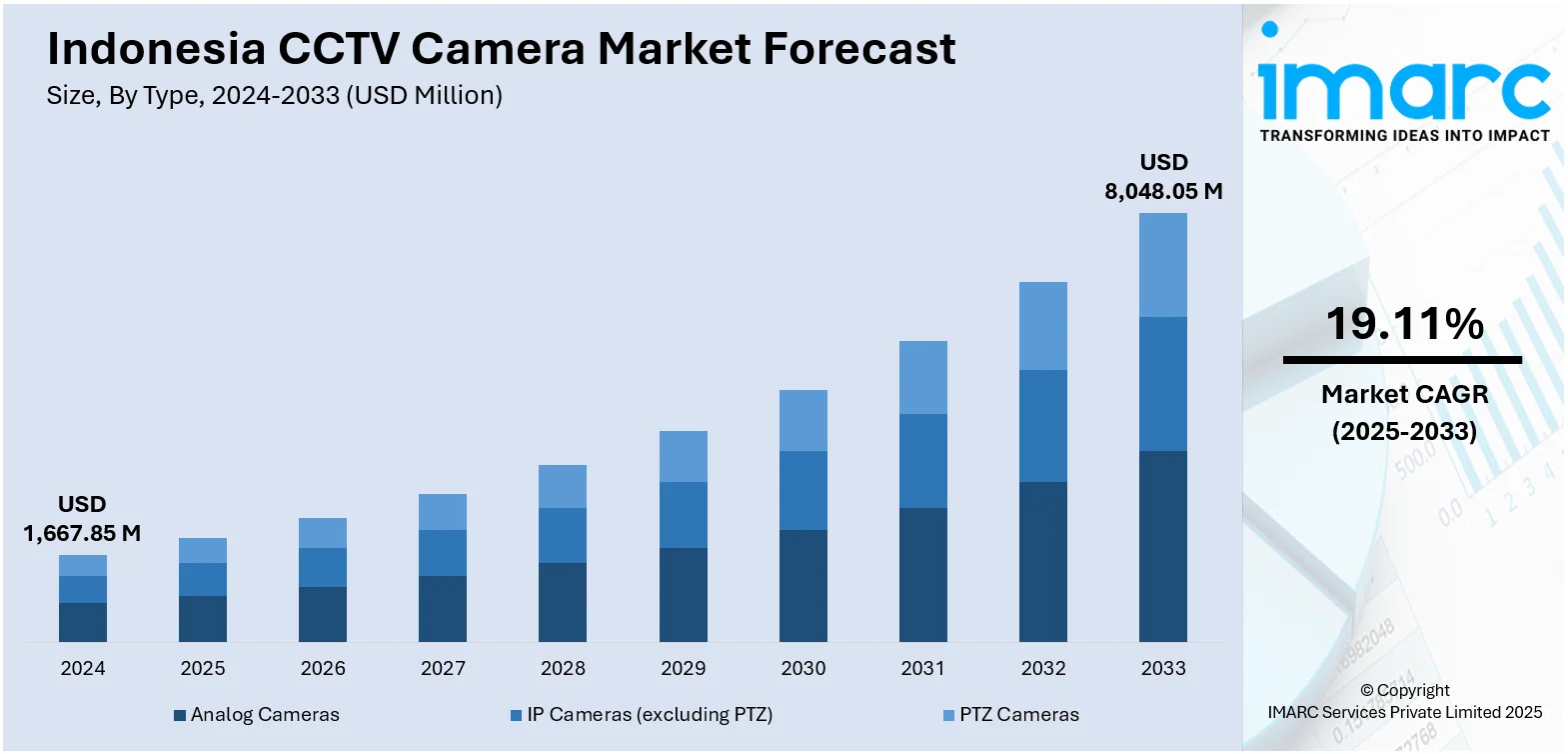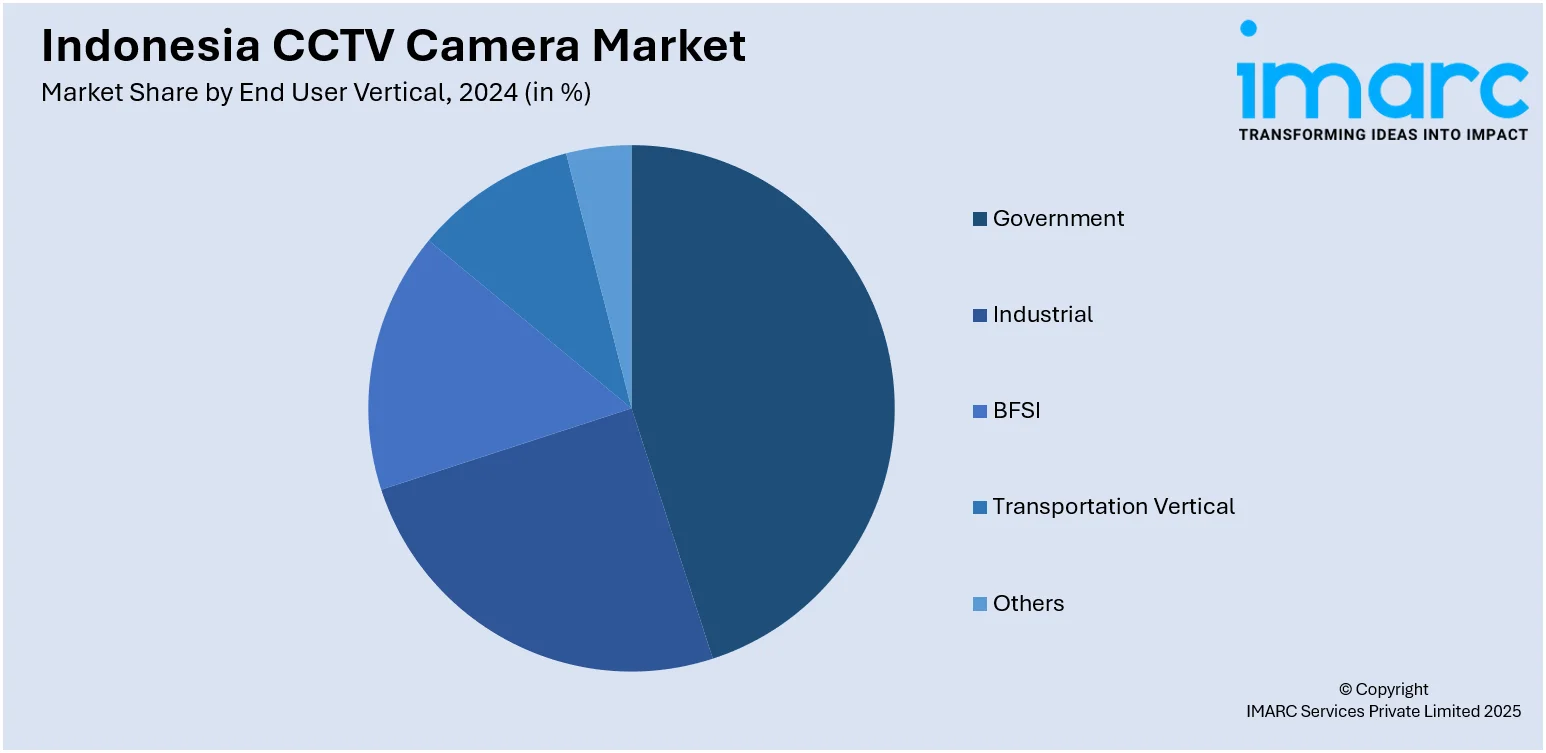
Indonesia CCTV Camera Market Size, Share, Trends and Forecast by Type, End User Vertical, and Region, 2025-2033
Indonesia CCTV Camera Market Overview:
The Indonesia CCTV camera market size reached USD 1,667.85 Million in 2024. Looking forward, the market is projected to reach USD 8,048.05 Million by 2033, exhibiting a growth rate (CAGR) of 19.11% during 2025-2033. The market is witnessing steady growth due to rising concerns over public safety, increased investments in urban infrastructure, and the adoption of smart surveillance technologies. Government initiatives to modernize security systems in public and private sectors are further accelerating demand. Growing awareness among businesses and households is expanding the market footprint, positively influencing the Indonesia CCTV camera market share.
|
Report Attribute
|
Key Statistics
|
|---|---|
|
Base Year
|
2024
|
|
Forecast Years
|
2025-2033
|
|
Historical Years
|
2019-2024
|
| Market Size in 2024 | USD 1,667.85 Million |
| Market Forecast in 2033 | USD 8,048.05 Million |
| Market Growth Rate 2025-2033 | 19.11% |
Indonesia CCTV Camera Market Trends:
AI-Driven Analytics Fueling Next-Gen Surveillance
The adoption of AI-driven analytics is swiftly changing the video surveillance landscape in Indonesia. Features like “facial recognition, intrusion detection, license plate recognition, and behavior analysis are becoming commonplace in both public and private sectors. For instance, in July 2025, Indosat launched Vision AI, an advanced surveillance solution leveraging artificial intelligence to enhance security and operational efficiency across various industries in Indonesia. This system offers real-time event analysis, privacy protection, and adaptability for different sectors, marking a shift from traditional surveillance to a more proactive approach. These advanced capabilities facilitate proactive security management by enabling systems to spot anomalies, issue real-time alerts, and promote faster decision-making. Sectors such as businesses, retail spaces, and critical infrastructure are particularly gaining from improved operational visibility and reduced risk. Additionally, government-led smart city initiatives are integrating AI-powered surveillance to oversee urban activities and enhance public safety. As artificial intelligence continues to develop, its influence in predictive surveillance, crowd behavior analysis, and event forecasting is projected to grow. This heightened dependence on AI technologies is a major factor driving the growth of the CCTV camera market in Indonesia, steering it toward more intelligent, automated, and scalable solutions.

To get more information on this market, Request Sample
Smart City Integration
The incorporation of CCTV systems into smart city frameworks is significantly driving the Indonesia CCTV camera market growth. Urban authorities are increasingly integrating surveillance infrastructure within transportation networks, public areas, and government facilities to improve safety, enhance traffic management, and assist emergency response systems. These modern systems feature real-time video analytics for the quick detection of suspicious behaviors and violations. For instance, in May 2024, Indonesia's new capital, Nusantara, was announced as a tech-enabled smart city by integrating high-speed internet, IoT, and AI. The government aims for economic equality while focusing on sustainability. Autonomous buses will enhance transportation, and an Integrated Command and Control Centre will utilize CCTV and AI for better monitoring and safety. The emphasis on digital governance and smart urban planning in cities like Jakarta and Surabaya further supports the implementation of advanced video surveillance. This movement aligns with national objectives aimed at creating sustainable, connected cities, where CCTV systems are vital for environmental monitoring, crime reduction, and infrastructure oversight. Consequently, there is a growing demand for high-resolution, AI-enabled cameras with centralized data management, which is driving substantial market growth throughout Indonesia’s metropolitan and emerging regions.
Indonesia CCTV Camera Market Segmentation:
IMARC Group provides an analysis of the key trends in each segment of the market, along with forecasts at the country and regional levels for 2025-2033. Our report has categorized the market based on type and end user vertical.
Type Insights:
- Analog Cameras
- IP Cameras (excluding PTZ)
- PTZ Cameras
The report has provided a detailed breakup and analysis of the market based on the type. This includes analog cameras, IP cameras (excluding PTZ), and PTZ cameras.
End User Vertical Insights:

- Government
- Industrial
- BFSI
- Transportation Vertical
- Others
A detailed breakup and analysis of the market based on the end user vertical have also been provided in the report. This includes government, industrial, BFSI, transportation vertical, and others.
Regional Insights:
- Java
- Sumatra
- Kalimantan
- Sulawesi
- Others
The report has also provided a comprehensive analysis of all the major regional markets, which include Java, Sumatra, Kalimantan, Sulawesi, and others.
Competitive Landscape:
The market research report has also provided a comprehensive analysis of the competitive landscape. Competitive analysis such as market structure, key player positioning, top winning strategies, competitive dashboard, and company evaluation quadrant has been covered in the report. Also, detailed profiles of all major companies have been provided.
Indonesia CCTV Camera Market News:
- In April 2025, the Jakarta Provincial Government announced its plans to install 30,000 CCTV cameras at public facilities, with an estimated budget of Rp380 Billion (USD 24 million). This initiative aims to combat theft, following incidents like the recent steel plate theft at the Daan Mogot pedestrian bridge.
Indonesia CCTV Camera Market Report Coverage:
| Report Features | Details |
|---|---|
| Base Year of the Analysis | 2024 |
| Historical Period | 2019-2024 |
| Forecast Period | 2025-2033 |
| Units | Million USD |
| Scope of the Report |
Exploration of Historical Trends and Market Outlook, Industry Catalysts and Challenges, Segment-Wise Historical and Future Market Assessment:
|
| Types Covered | Analog Cameras, IP Cameras (excluding PTZ), PTZ Cameras |
| End User Verticals Covered | Government, Industrial, BFSI, Transportation Vertical, Others |
| Regions Covered | Java, Sumatra, Kalimantan, Sulawesi, Others |
| Customization Scope | 10% Free Customization |
| Post-Sale Analyst Support | 10-12 Weeks |
| Delivery Format | PDF and Excel through Email (We can also provide the editable version of the report in PPT/Word format on special request) |
Key Questions Answered in This Report:
- How has the Indonesia CCTV camera market performed so far and how will it perform in the coming years?
- What is the breakup of the Indonesia CCTV camera market on the basis of type?
- What is the breakup of the Indonesia CCTV camera market on the basis of end user vertical?
- What is the breakup of the Indonesia CCTV camera market on the basis of region?
- What are the various stages in the value chain of the Indonesia CCTV camera market?
- What are the key driving factors and challenges in the Indonesia CCTV camera market?
- What is the structure of the Indonesia CCTV camera market and who are the key players?
- What is the degree of competition in the Indonesia CCTV camera market?
Key Benefits for Stakeholders:
- IMARC’s industry report offers a comprehensive quantitative analysis of various market segments, historical and current market trends, market forecasts, and dynamics of the Indonesia CCTV camera market from 2019-2033.
- The research report provides the latest information on the market drivers, challenges, and opportunities in the Indonesia CCTV camera market.
- Porter's five forces analysis assist stakeholders in assessing the impact of new entrants, competitive rivalry, supplier power, buyer power, and the threat of substitution. It helps stakeholders to analyze the level of competition within the Indonesia CCTV camera industry and its attractiveness.
- Competitive landscape allows stakeholders to understand their competitive environment and provides an insight into the current positions of key players in the market.
Need more help?
- Speak to our experienced analysts for insights on the current market scenarios.
- Include additional segments and countries to customize the report as per your requirement.
- Gain an unparalleled competitive advantage in your domain by understanding how to utilize the report and positively impacting your operations and revenue.
- For further assistance, please connect with our analysts.
 Request Customization
Request Customization
 Speak to an Analyst
Speak to an Analyst
 Request Brochure
Request Brochure
 Inquire Before Buying
Inquire Before Buying




.webp)




.webp)












